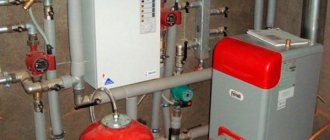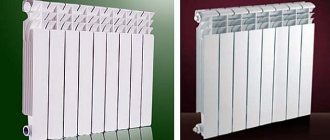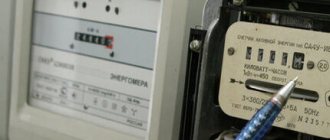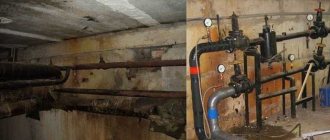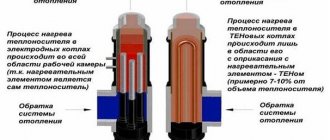New in blogs
Working as the chief engineer in the housing and communal services sector, for some time I had in my hands the calculation of water and water heating, and I told them to pay attention to this.
Here's an example:
Let’s take any metering device that calculates the consumption of thermal energy for heating water, and a residential building at any address that has, for example, 100 apartments and, accordingly, 100 coils and the consumption according to the readings of a commercial thermal energy metering device at the end of the month:
42.2 Gcal, 654 m3 and 738 hours.
As before: The actual consumption of the device was 42.2 Gcal and 654 m3 for 738 hours . The water component for each cube is:
42.2/654=0.0645 Gcal/m3
It’s easier to charge this component to everyone according to their hot water consumption; if there is no consumption, then no one pays for thermal energy, and the circulation coil works independently whether there is a consumption or not. A standard for the consumption of thermal energy for water heating is also derived based on the readings of standard houses, and approved by local executive and administrative bodies for houses that are not equipped with metering devices, or these devices are out of order.
In a new way: The actual consumption of the device is also 42.2 Gcal and 654 m3 for 738 hours . But 42.2 Gcal includes the consumption of thermal energy for hot water and circulation (operation of coils) .
All that remains is to distribute it correctly.
As a basis, I took the distribution of thermal energy of houses, where the device takes into account both the heating and hot water supply of the house, as well as the calculation of the physical quantity, how much thermal energy needs to be spent to heat 1 m3, for example: Tg.v. = 55 ° C (this temperature can be any) ; Тх.в.=10оС (this is the temperature of cold water, which is mostly stored in metering devices by default). The formula for the calculation is familiar to thermal engineers, namely, if we take into account the density of water gw = 1000 kg/m3 , (Tg.w - Th.w) / 1000 = Gcal/m3 . In our case:
(55-10)/1000=0.045 Gcal/m3
This value may vary depending on the density, heating temperature, cold water temperature, etc., it can be accepted and approved by local executive and administrative bodies, but it is more or less constant, this is physics.
The easiest way is to multiply this component by the total water consumption and subtract it from the meter readings, and take the rest as the thermal energy expended on circulating water through the basement and coils. But this is not entirely correct, since this does not yet reflect the actual consumption of thermal energy for heating water, because there can be both overheating and underheating, which are displayed on the commercial meter.
Therefore, I propose to confirm a constant amount of thermal energy spent on transporting hot water through the basement, technical floor, sanitary cabin shafts, as well as the amount of heat given off by heated towel rail registers during the day, which is equal to 0.0045-:-0.005 Gcal (this is a reference value) , depending on the period.
Thus, knowing that there are 100 apartments (which means 100 coils ), and that there are 31 days or 744/24 , the estimated amount of thermal energy for transporting (circulating) water through the coils in our case is equal to:
0.005x100x738/24=15.375 Gcal
The total estimated amount of thermal energy is:
0.045x654+15.375=44.805 Gcal
Let me remind you that the actual consumption of thermal energy according to the commercial metering device was 42.2 Gcal .
This means that the actual consumption of thermal energy only for heating water is determined by the formula:
(42.2/44.85)x0.045x654=27.7 Gcal
The actual amount of thermal energy for transporting (circulating) water through the coils is equal to:
(42.2/44.85)x0.005x100x(738/24)=14.5 Gcal
We check:
27.7+14.5=42.2 Gcal
, which corresponds to the meter readings.
This means that the house needs to be charged: for water heating - 27.7 Gcal , which corresponds to 0.042 Gcal/m3 , and for transportation (circulation) through the coils - 14.5 Gcal , which corresponds to 0.145 Gcal from the apartment.
THIS IS RIGHT !!!.
What is it for:
— firstly , everyone must pay for hot water, including those whose consumption is zero; -secondly , it is not so expensive for apartments with high expenses, they will pay less; -thirdly , the enterprise and organization will pay less for losses (after all, no more than the water standard is billed to the population); -fourthly, this technique is acceptable for any home and for any appliances; - fifthly - it will be correct.
METHOD FOR DETERMINING THE AMOUNT OF THERMAL ENERGY FOR HEATING 1 CUBIC. METERS OF WATER AND FOR TRANSPORTATION (CIRCULATION) OF HOT WATER IN A RESIDENTIAL HOUSE EQUIPPED WITH A METERING DEVICE
1. The amount of thermal energy for heating water, payable by the population of a residential building, in terms of 1 cubic meter of water is determined by the formula
Q1 = x N1, Gcal/1 cubic meter,
where Q is the amount of thermal energy determined according to the readings of the device that carries out general accounting of the amount of thermal energy for transportation (circulation) and heating of water, minus the amount of thermal energy for heating water in built-in (attached) non-residential premises of a residential building, Gcal; V is the volume of hot water consumption by the population of a residential building, cubic meters; N1 - standard amount of thermal energy for heating 1 cubic meter of water for the reporting month, approved by the local executive and administrative body, Gcal; N2 - standard amount of thermal energy for transporting hot water through the basement, technical floor, plumbing shafts, as well as the amount of heat released by heated towel rail registers during the day, approved by the local executive and administrative body, for the reporting month, Gcal. b – number of apartments in a residential building (group of residential buildings); n – number of days of operation of the hot water supply system per month; 2. The amount of thermal energy for transportation (circulation), subject to payment by the population of a residential building, recalculated per 1 coil is determined by the formula
Q2 = x N1, Gcal
Designations Q, V, N1, N2, b, n correspond to similar designations specified in paragraph 1 of this appendix.
How many cubic meters are in a gigacalorie? Let's learn how to calculate heating costs taking into account odpu
How to convert gigacalories to cubic meters
When receiving utility bills, it is quite difficult to understand many aspects of the calculations and understand: where did this or that figure come from? One of the most striking examples of such “translation difficulties” is payment for supplied heat. If your home has a single heat meter installed, then you will receive bills for the Gcal (gigacalories) used, but the tariff for hot water, as you know, is set for cubic meters. How to figure out how to calculate the cost of heat?
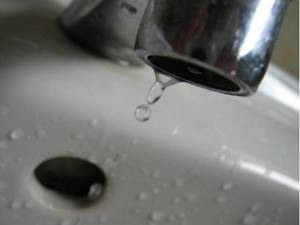
Instructions
1
Perhaps the greatest difficulty lies precisely in the technical impossibility of converting gigacalories into cubic meters or vice versa. These are completely different physical quantities: one serves to measure thermal energy, the other – volume, and, as a basic physics course suggests, they are incomparable. The task of the utility consumer ultimately comes down to calculating the ratio of the amount of heat expended and the volume of hot water consumed.
2
In order not to get completely confused, it is worth starting with determining the calculated values. So, by calorie we mean the amount of heat that is necessary to heat one cubic centimeter of water by 1°C. There are a billion calories in a Gcal, and a million centimeters in a cubic meter, therefore, to heat one cubic meter of water by 1°C you will need 0.001 Gcal.
Considering that hot water should not be colder than 55°C, and cold water arrives at a temperature of 5°C,
Obviously, you will need to heat it by 50°C, that is, spend 0.05 Gcal of thermal energy on each cubic meter. In the sphere of housing and communal services tariffs, there is a slightly higher heat consumption standard for heating one cubic meter of water - 0.059 Gcal, this is due to heat losses that occur when transporting water through a pipeline.
3
Then everything is simple, divide the heat consumption according to the readings of the house meter by the number of residents. In this way, obtain the heat consumption for each resident, and dividing the resulting figure by the standard 0.059 is the volume of hot water in cubic meters that must be paid for by each resident. The only subtlety in this calculation is the need to subtract from it those residents who have consumption meters installed in their apartment.
4
Let's look at the calculation using an example: the consumption according to a common house meter was 30 Gcal, residents who have internal metering devices used a total of 35 m³ of hot water, residents without metering devices in the house - 75 people.
5
We count:
35*0.059 = 2.065 – this is the amount of heat consumed by residents who have metering devices;
30-2.065 = 27.935 Gcal – the balance of consumption for the remaining residents;
27.935/75 = 0.372 Gcal – heat consumption per resident;
0.372/0.059 = 6.31 m³ of hot water will be billed to each tenant whose apartments are not equipped with metering devices.
More details: https://www.kakprosto.ru/kak-108400-kak-perevesti-gigakaloriyu-v-kubicheskie-metry#ixzz2mtUe7egh
How much kWh of energy is spent heating water?
This calculator will calculate how much money, electricity and time is spent heating water. You don't need any formulas or coefficients: just enter your data and get the answer.
To calculate the consumed electricity, you must indicate the temperature of cold and hot water, as well as its volume (mass). You can indicate the efficiency of the heating device if you know it. If you set the efficiency to 100%, the calculation will show only the useful power spent on heating water. When indicating the real efficiency, the calculation will give the total power consumed from the network.
To estimate how long it takes to heat up, indicate the power of the electrical appliance you use to heat water, in kilowatts (kW). The power is often indicated on the body of the device, as well as in its instruction manual or passport.
Boiling water in an electric kettle
I usually fill the kettle with water at room temperature 20°C to the 1 liter mark and always bring it to a boil (up to 100 degrees). Kettle power 2 kW. The simplest calculation shows that boiling will cost approximately 0.1 kWh (kilowatt hours) of electricity, 3 minutes of time, and, according to Moscow tariffs, fifty kopecks of money.
This means that each tea drink adds half a ruble to your electricity bill, but this is significantly less than the price of a serving of tea or coffee.
Heating water in a storage water heater
Every time I take a shower, I completely empty all the hot water from the storage heater, because at the end the water turns cold. In winter, the heater heats cold tap water from 5 to 45 degrees. Tank volume 80 liters. With a heating element power of 2 kW, fresh water in the tank will heat up for 2 hours, while approximately 4 kW of electricity and 20 rubles of money will be spent to pay for it. In summer, the water heats up from 18 to 45.
This means that in winter, each shower costs the family treasury 20 rubles, and in summer - 15 rubles, not counting the cost of cold water.
Despite today's wide range and functionality of electric boilers produced by various manufacturers, their homemade analogues have not lost their relevance in our time.

This is primarily due to the lower cost of the latter, therefore, to heat water, say for a summer shower or a washbasin in the country, many often use homemade electric water heaters, which are structurally a container with a heating element - a heating element.
Swimming pool calculations
The calculation of heating water in a pool consists of calculating the parameters of the electric heater and the volume that needs to be heated. The table shows the approximate time in hours during which the temperature rises from 10 °C to 28 °C. In this case, the area of the water “mirror”, the ambient temperature, and the degree of openness/closeness of the pool location play a significant role in the final calculations.
When calculating the power of electric heating elements, the following calculation data were used: mass of water, initial and final (desired) water temperature and time spent on heating.
Heating element power P
P=0.0011m(tk-tн)/T
.
in which: m
is the mass of heated water,
tk
and
tн T
The calculation of the power of the heating element is performed by this calculator without taking into account heat losses associated with the design features of the container, ambient temperature, the state of the heating surface of the heating element, etc.
In addition, you should take into account the actual supply voltage, which may differ greatly from the nominal value.
So, at a reduced voltage, the temperature of the working surface will be less than the value declared by the manufacturer, therefore, more time will be required for heating.
Considering the specific gravity of water is 1 g/cm3, the value of its volume can be used in the “Mass of heated water” calculator field when entering data.
When heating cold water from city water supply systems, the recommended initial temperature is 5-8°C in summer and 13-18°C in winter. The result of the calculation (P) can be the power value of either one heating element or several parallel-connected elements.
Electrical calculations online
© Forum220.ru | 2009 – 2015 | Electrical engineering calculations online Placing these materials on other web resources is possible only if there is a hyperlink back to the site Forum220.ru
Water heating time calculator

